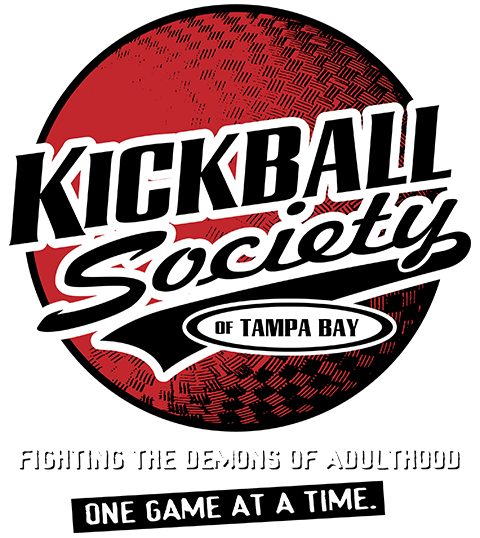RULES OF THE KICKBALL SOCIETY
Rule #1 : HAVE FUN! Yeah, it’s more fun to win than lose but this is not the place to make up for that unclaimed glory from your high school days. It’s about getting together with friends, meeting new people and having a good time.
Rule #1A : NO WHINING! It’s kickball, for crying out loud!
Rule #1A : NO WHINING! It’s kickball, for crying out loud!
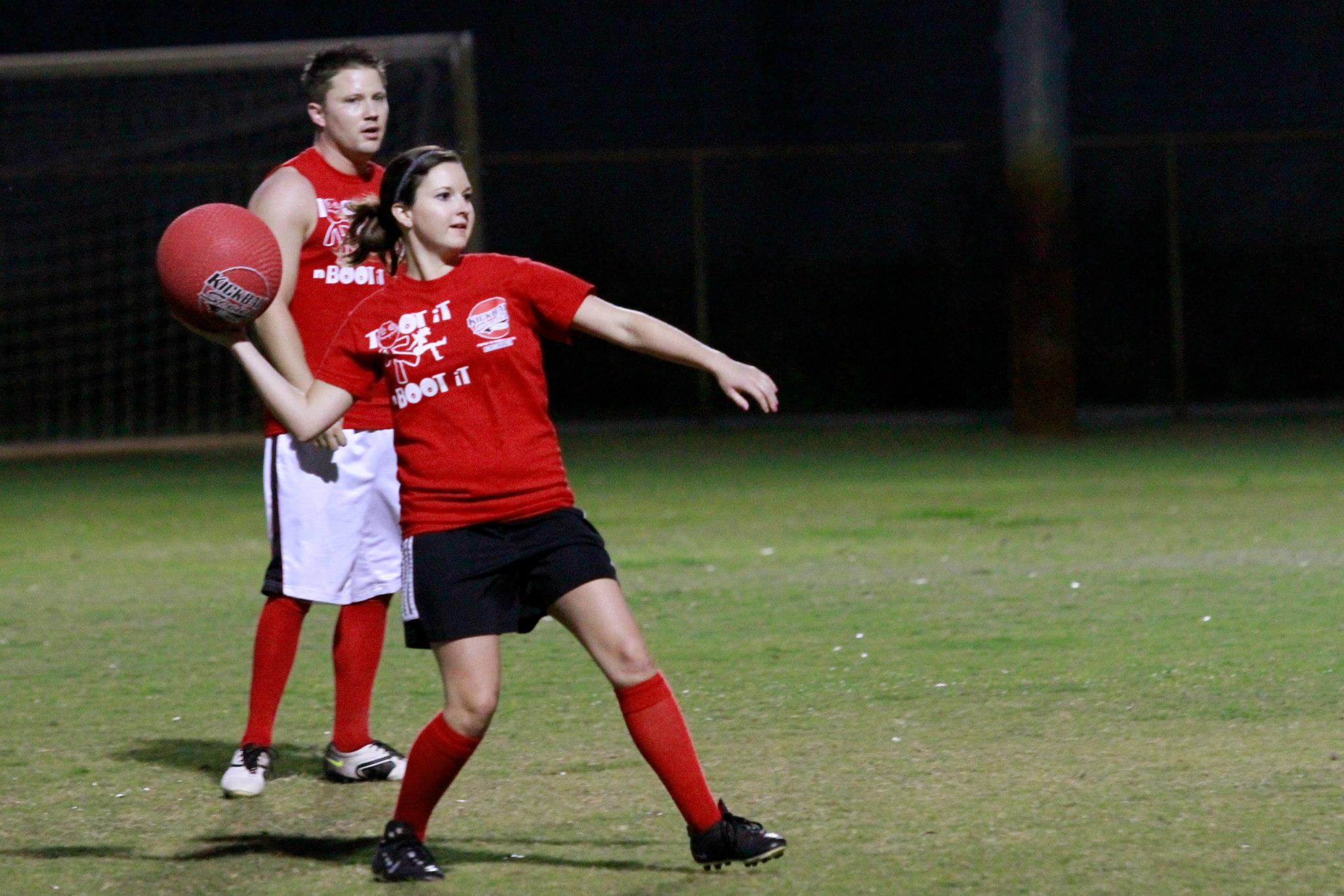
Team
Each team has, on average, 16 players. All team members must be at least 21 years of age and can only play on the team with which they are registered.
Teams can have a maximum of 11 players on the field at a time, with a minimum of five women. If a team is playing with less than 10 players, they are not required to have a catcher. While there is no minimum number of players required on the field, a team may not field more than one more male player than female player at any time.
Teams can have a maximum of 11 players on the field at a time, with a minimum of five women. If a team is playing with less than 10 players, they are not required to have a catcher. While there is no minimum number of players required on the field, a team may not field more than one more male player than female player at any time.
Each team needs a Captain, who will be the ‘Person in Charge’ (PIC). The PIC is responsible for the following:
- designating someone to take his/her place if they cannot be at a game
- ensuring that everyone playing is eligible
- setting the kicking order for the game and ensuring it stays the same
- disputing a call on the field
- remaining cool, calm and collected always
- certifying game results
- ensuring the team understands the rules
- communicating with team members as necessary
- communicating with the league and attending League Captain meetings
- taking care of miscellaneous team items, as needed

Field and Equipment
The kickball field resembles a softball field. Bases are ~60 feet apart and the pitcher’s strip is located in the middle of all bases. There is also an imaginary or dashed line between first base and third base. The strike zone is 18” on either side of home plate and will be designated by cones, as are the foul lines. Kickball Society will provide equipment, including bases, cones and kickballs.
- METAL CLEATS ARE NOT ALLOWED to be worn in kickball games
Officials
- Referees will have the final say on any disputes. The referee’s authority is granted by a higher power and referees have the right to penalize or eject players who exhibit unsportsmanlike conduct.
- Only the captain or his/her designee can dispute calls with the referee.
- In the event of any situations not specifically addressed in the rules, the referee will make the call. Whatever their call, that’s how it is. Refer to Rule 1A above.
- When a captain appeals a call that was made on the field, the side referees will be asked to join the main referee in the middle of the field at the pitching mound. We ask that the pitcher vacate the mound and go to first or third base while the refs talk over the call and the final call to the appeal. Once the meeting is over, the main ref will make the final judgment on the call. Either captain can then ask the main ref for an explanation of the final call. Remember TIME does not STOP
- Teams have TWO (2) appeals during each regular season game ; THREE (3) appeals during Playoffs.
General Game Rules
- Team players must wear their official Kickball Society team shirts for games. After all, that’s why you have them! Teams are encouraged to be creative and may modify shirts as long as they do not change the Kickball Society logo or other logo pre-printed on the shirt. Nothing offensive, however!
- All team players present must be placed in the kicking order prior to the start of the game and the kicking order remains the same for the entire game. If players arrive after the game is started, they are added to the end of the kicking order.
- Each team may have up to 11 players when they are in the field position, including a catcher. Fielding positions are set at the beginning of the inning and must remain the same for the entire inning. NO SWITCHING POSITIONS.
- If a player is injured during play, the captain may make a substitution for the injured player. The injured player may later return to the game if they are able but can only return once in any game. If the injured player is a base runner, the person of the same sex who made the last out must replace them. Pinch running can only happen twice per game per person.
- Games will be at least 45 minutes in length. At the end of 45 minutes, the game will continue until each team has had the same number of ‘at bats’ unless the home team is ahead, in which case the game is over.
- Start time is GAME TIME! Kicking order and Captains Meeting with the head referee will happen no later than five (5) minutes after the scheduled start of game. Late arrivals will be added to the bottom of the kicking order.
- Official Game Time starts at 10 minutes past the scheduled time of the game, no exceptions — CLOCK STARTS! (I.E. 7:10 / 8:10)
- If a regular season game is tied at the end of the allotted game time, it will be recorded as a tie. In a tournament/playoff game, teams will start with the person who made the last out on second base and play will continue. The team with the most runs after both have kicked wins the game. If the game is still tied, additional complete innings will be played until a team is ahead.
- If a team is unable to field a complete team, the game may be delayed up to 10 minutes from the scheduled start time to allow additional players to arrive. If a team does not have more than eight players by that time, they have an option to forfeit the game. Forfeit games shall be recorded at a 7-0 score.
- Home team and visiting team status will be determined by the captains using “Rock-Paper-Scissors.” Home team takes the field first and kicks last.
- If a game is delayed due to weather and cannot be completed, 22:30 minutes (half-way point) will constitute a complete game. If the game is not completed, it will be made up under the rain out rules.
- If league play is cancelled or games are not completed due to weather, best efforts will be made to adjust the schedule for the remaining league nights to make up the games. Captains will be informed of any future schedule changes.
- If league games are interrupted by weather, team members should safely stay in the area, as the game may continue after a delay. Games that are delayed will pick up at the same point that they were suspended. If a team leaves and is not available to continue a game as the referee indicates, that team will forfeit.
- If a team is behind by 12 or more runs at the end of any inning, their Captain may choose to end the game.
Pitching
- The pitcher may take one step prior to releasing the pitch and must have their forward foot on or behind the pitching strip when the ball is released. The pitcher must start with both feet completely on the mat and finish on the mat or on top of the pitching rubber. The pitcher must stay on the mat until the pitch is released. No running starts and no overhand, sidearm or windmill pitches. All pitches must be underhand.
- All pitches must roll on the ground in a straight line from the pitcher’s release to home plate and must roll across home plate. Bouncing pitches are balls, as are any pitches that curve rather than going straight. If a ball bounces slightly as it crosses home plate and the referee feels the intent of the pitcher was not to bounce the ball, it will be called a strike.
- The pitcher must stay behind the pitching strip until the ball is kicked. All infielders must stay behind the imaginary line between first and third base. Failure to do so will result in the referee calling the pitch a ball.
- Any pitch made by the pitcher that CURVES at any point after release and does not roll in a straight line as it rolls towards homeplate will be called a BALL if the kicker doesn’t kick the ball. The referee will inform the pitcher of the illegal pitch. All pitches must be UNDERHAND only. If the pitching motion is from the SIDE or with a overhand motion, it will be called a BALL if the pitch is not kicked by the kicker. (THIS RULE DOES NOT APPLY IN COMPETITIVE DIVISIONS)
- Intentional Walk Rule:
A pitcher may intentionally walk a kicker to award him/her with one (1) base only by stating “Intentional Walk” to the Game Head Referee after at least one (1) strike / foul has been pitched. If a pitcher fails to pitch at least one (1) strike / foul to the kicker in the same at-kick (whether intentional or not), the result will be the kicker being awarded two (2) bases. If this occurs, base runners are permitted to advance only if forced to do so by kicker being awarded two (2) bases as a result of an Intentional Walk.
Catching
- The catcher must start directly behind the kicker, regardless of where the kicker begins their approach to home plate. The catcher may not cross home plate, be in front OR to the side of the kicker before the ball is kicked. Catchers cannot position themselves so closely that they interfere with a kicker’s motion and must remain behind the kicker before the kicker touches the pitched ball. Failure to do so will result in an automatic advance to first base.
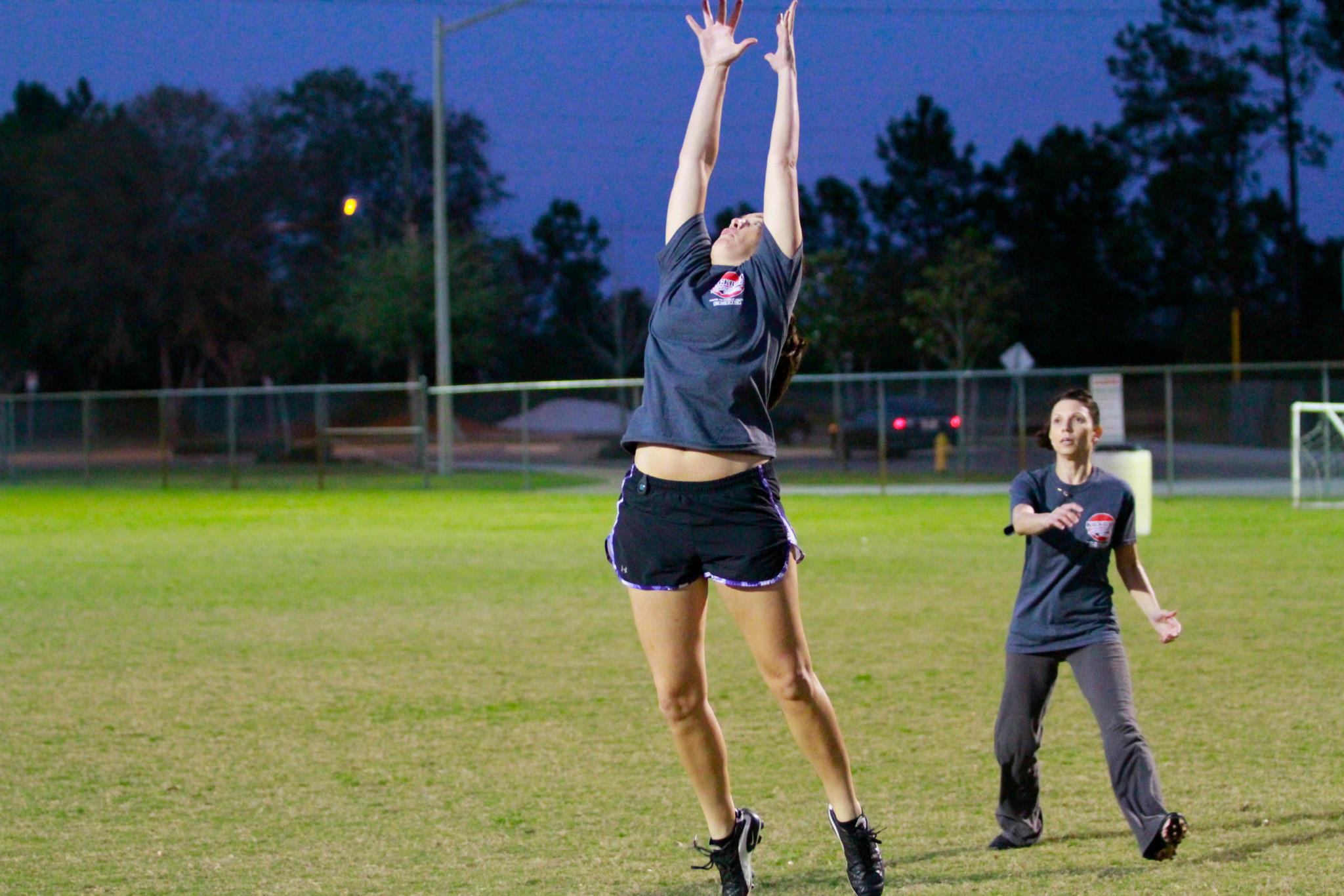
Kicking
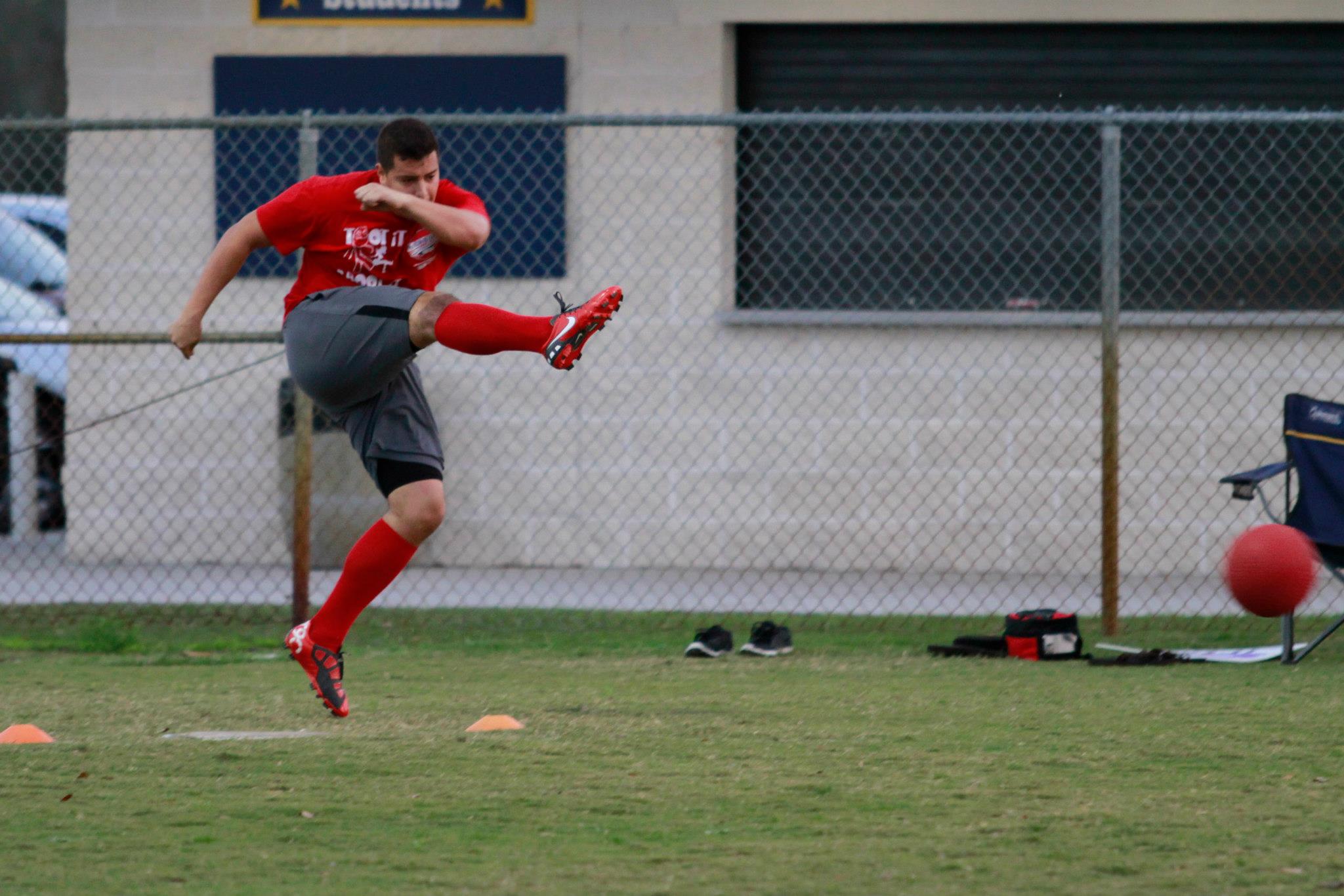
- The kicker must wait until the ball reaches the front edge of home plate before kicking. If the player kicks the ball ahead of the plate, it’s a foul ball. If the ball is kicked and caught in the air, it is an OUT. If the ball is kicked and hits the ground, it will be called a foul ball once it touches the ground.
- Kicks must be made with the foot but any contact with the foot or lower leg counts as a kick, and therefore a strike, a hit or a foul can be called.
- Bunting is only allowed for women! Men must kick the ball (See below.)
- Male Kickers ONLY: The kicker may use the front, top or side of their foot to make contact with the ball. However, the kicking motion must be a full forward motion (with full back and forward extension). A side kick (kicking in a side manner across one’s body) is not a legal kick and will be considered a foul ball. Stopping the forward motion of the kick will be considered a bunt and will result in a foul ball. The referee will determine the motion of the kick. If the kicked ball is caught in the air, it will result in a OUT. If it hits the ground, it will be called foul and be a foul ball on the kicker.
Running
- NO SLIDING INTO first base. If kicker slides into first base from home plate, they will be called OUT. A runner can slide back to first base only if coming back to the bag to tag up or return to the base after leaving the first base bag.
- If a runner misses a bag while rounding the bases, the defense may challenge by tagging the base prior to the next pitch and the referee will call the runner safe or out. This challenge will not count against the appeals for the game.
- DURING PLAYOFFS ONLY: If a head referee sees a baserunner miss a bag, the head referee will call the baserunner out AFTER the play has stopped and the result of the out will determine if any scored runs will be adjusted.
- Runners cannot leave the base until the ball is kicked. That means no stealing or leading off. Leaving early is an automatic out. Runners cannot pass the runner in front of them, that is also an out.
- Runners must stay in the baselines. The baselines are a straight line between two bases that’s about five feet wide. If a runner goes outside the baseline to avoid being tagged, they’re out. Not so if they need to go outside to avoid a fielder blocking the baseline. See next rule.
- Fielders must stay out of the base lines unless they’re trying to tag a runner or making a play. If a fielder unfairly hinders a runner, they are safe at the base to which they’re headed.
- A runner cannot be hit with the ball above shoulder level. Any runner hit above their shoulders advances one base. However, if a runner deliberately uses his head to block the ball, the runner is out. If the runner gets hit above the shoulders while ducking, diving or sliding in an attempt to avoid the ball, the runner is out.
- Runners must tag up for a fly ball before they can advance. A runner may advance on a pop fly once the ball is actually touched by a fielder attempting a catch.
Interference at First Base:
- ANY collision or physical contact of the defense and/or the kicker/runner will result in the following rules being applied towards the call of interference at first base:
- When a player kicks the ball and runs to first base, the kicker who becomes a runner, who MUST run to the ORANGE safety bag if there is a play at first base. The defense must use the white bag ONLY to make the force out. If the kicker goes to the white bag he/she will be called out even if the defense doesn’t make the force out if the ball is played towards first base. If the defense uses the orange bag, the runner will be called SAFE no matter what. The kicker/runner can use the WHITE bag on first base ONLY if the defense does not make a play towards first base while the ball is in play.
- If the defense crosses over the path of the kicker running to first base (behind or in front of the double bag), the defense can be called for interference, if the referee determines that the runner from home plate slowed down to avoid contact with the defense. The referee will determine if crossing over in front of the kicker with no collision or contact with the kicker slowed the kicker down in their approach to first base and will award first base to the runner, if necessary.
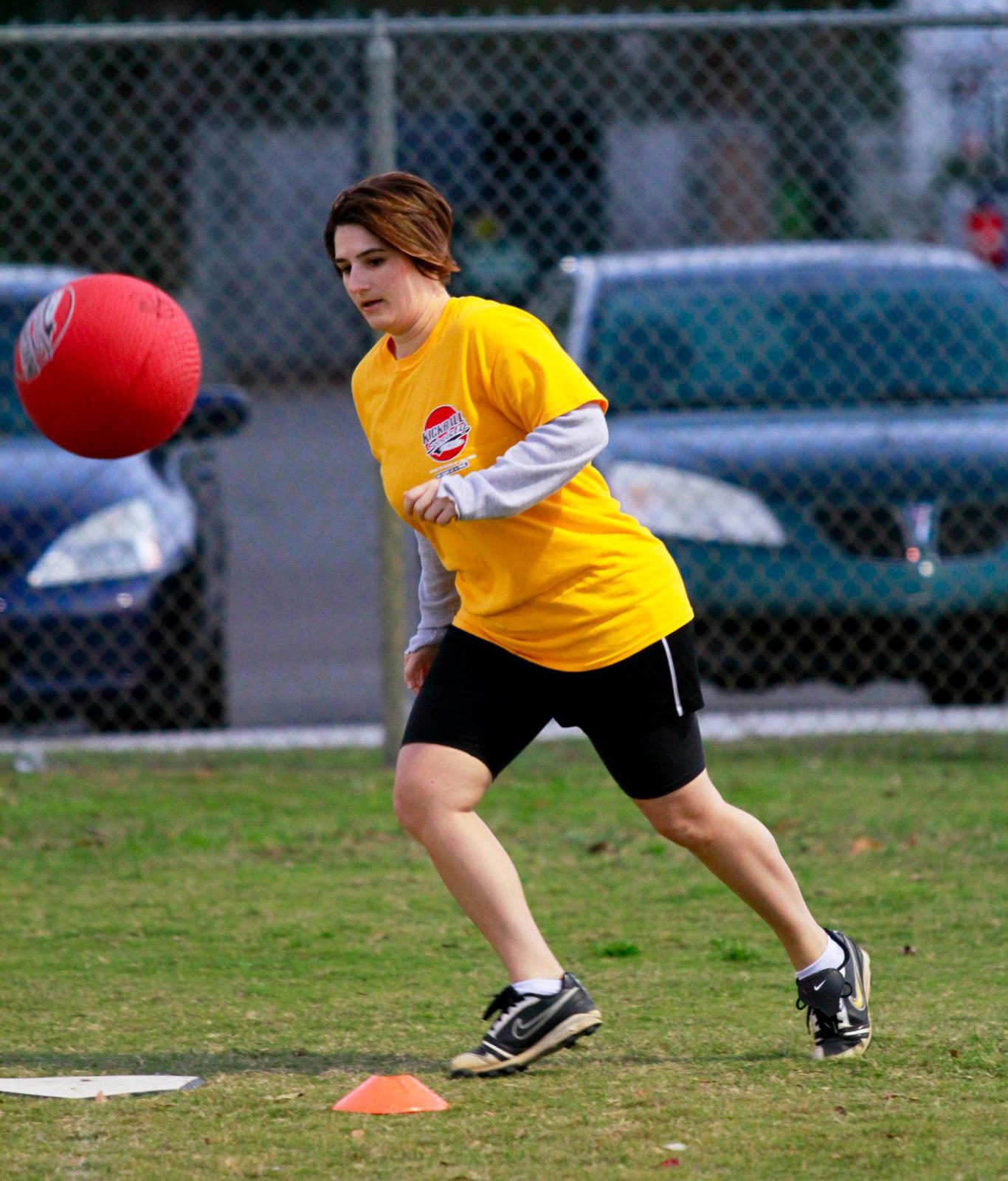
Balls
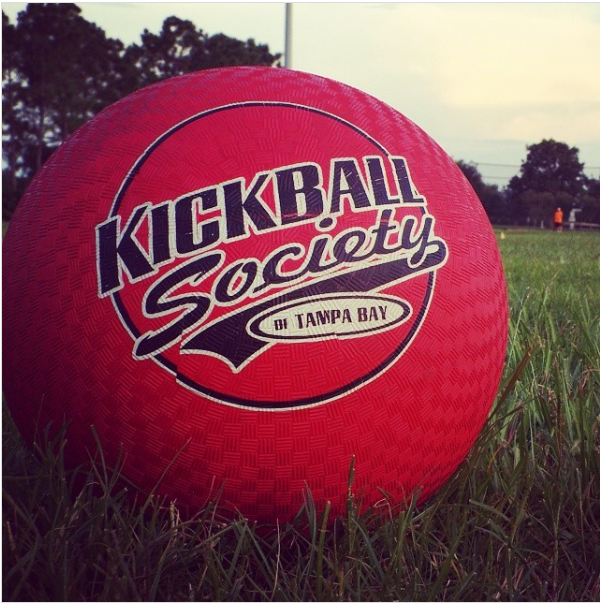
- Four (4) balls is considered a walk. The kicker will be awarded first base.
- A roll that touches the cones, or is outside of the cones is a ball.
- If the ball does not roll in a straight line from the pitcher to home plate and does not roll across home plate, it’s a ball.
- If during the pitch the ball touches the rubber strip plate on the pitchers mound it will be called a ball.
- If any player crosses that imaginary line between first and third base before the ball is kicked, it’s a ball.
Strikes
- Four (4) strikes and you’re out! Four strikes can be ANY combination of fouls or strikes.
- The strike zone is between the strike zone cones but does not include the cones. If the ball goes between the cones without touching them, it’s a strike. If the ball touches or goes over a cone, it’s a ball. The strike zone is about 12” as measured from the bottom of the ball and at the front of home plate.
- If the kicker attempts to kick the ball and misses, it’s a strike.
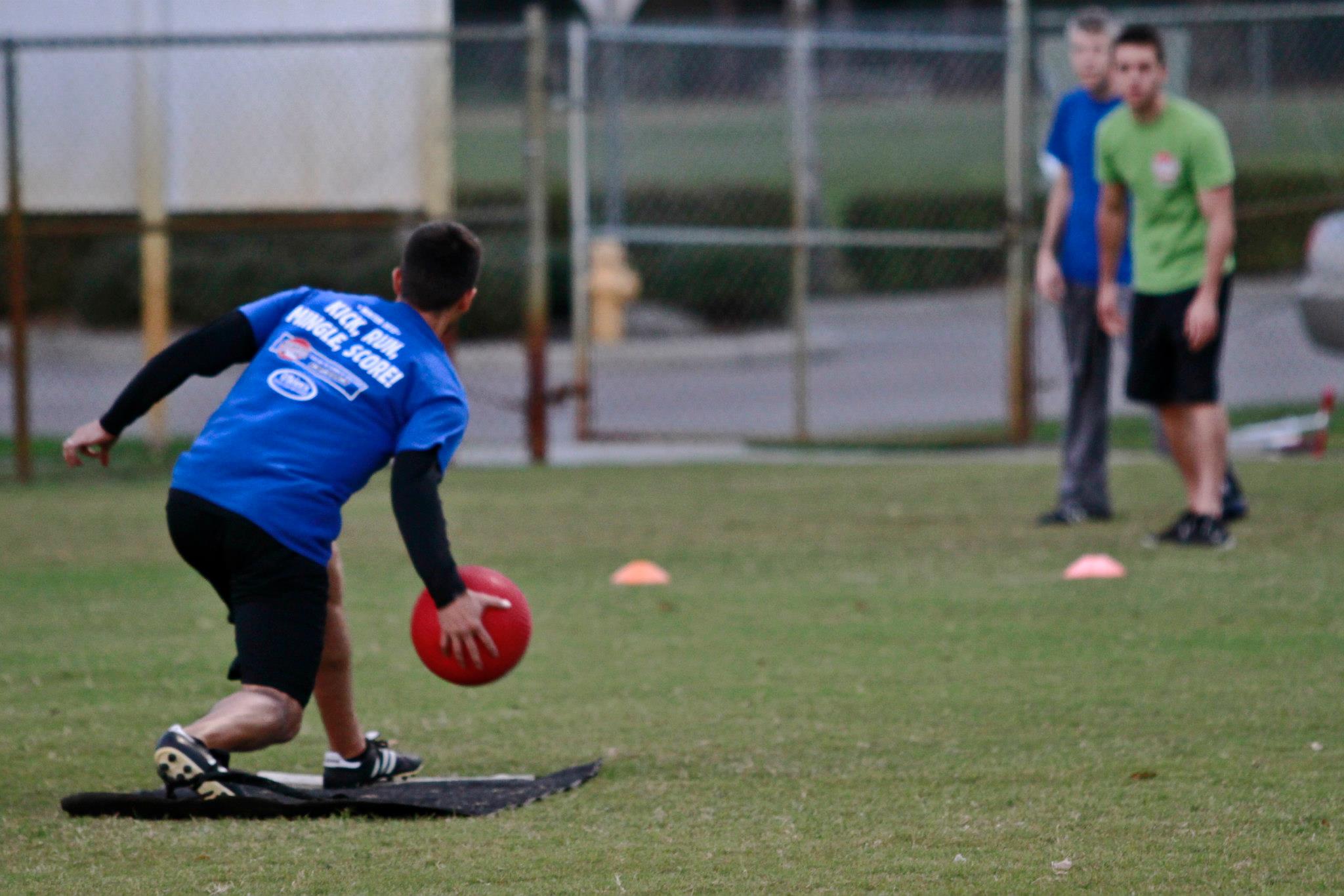
Fouls
- If a ball lands in foul territory without being touched, it’s a foul.
- If a ball hits a tree or other object in foul territory it’s a foul. No catching the ball on the rebound.
- If a ball is kicked and lands in fair territory but goes into foul territory before it passes first or third base, it’s a foul. However, if a fielder touches it before it goes out of bounds, it’s in play.
- If a ball touches the kicker but continues past him/her, it’s a foul.
- If a foul ball is caught as a fly, it’s an out.
- If the kicker kicks the ball in front of home plate, it’s a strike. That’s unless the ball is caught as a fly, in which case it’s an out.
Outs
- Any combination of four (4) strikes or fouls is an OUT.
- If a ball touches a runner while they are not on base, it’s an out, unless they’re hit above the shoulders.
- If a kick is caught before it hits the ground, it’s an out. However, a fielder may not intentionally drop a catchable ball to make a double play. If a referee determines that the ball was intentionally dropped, all players are safe at the next base and the kicker is safe at first. If the referee determines the drop was unintentional, play continues.
- If a runner leaves the base before the ball is kicked, it’s an out.
- If a player kicks out of order, it’s an out.
- If a fielder touches the base where a runner is forced to run to, it’s an out.
Ball in Play
- When any player has the ball in control in the infield and the lead runner is not in forward motion, the play ends unless the referee determines that a play is being made.
- Baserunners must not intentionally interfere with the defense fielding a ball in play. Baserunners cannot strike a ball in play knocking it out of the hands of the defense. Baserunner cannot deliberately contact a fielder or have deliberate/direct verbal interference with any fielder making a play on the ball. If any of this happens during a game, the baserunner will be called out and any baserunners on base will return to the base they were at prior to the interference.
- If the ball hits a wire in fair territory, the ball is dead and the player kicking the ball will re-kick.
- Interference happens when any non-fielder or other object touches the ball while it’s in play. That stops the play and runners will proceed to the base where they were headed. If a runner intentionally touches the ball, the pay ends, the runner is out and any other runners return to the base where they started.
Ball In Play - Foul Territory:
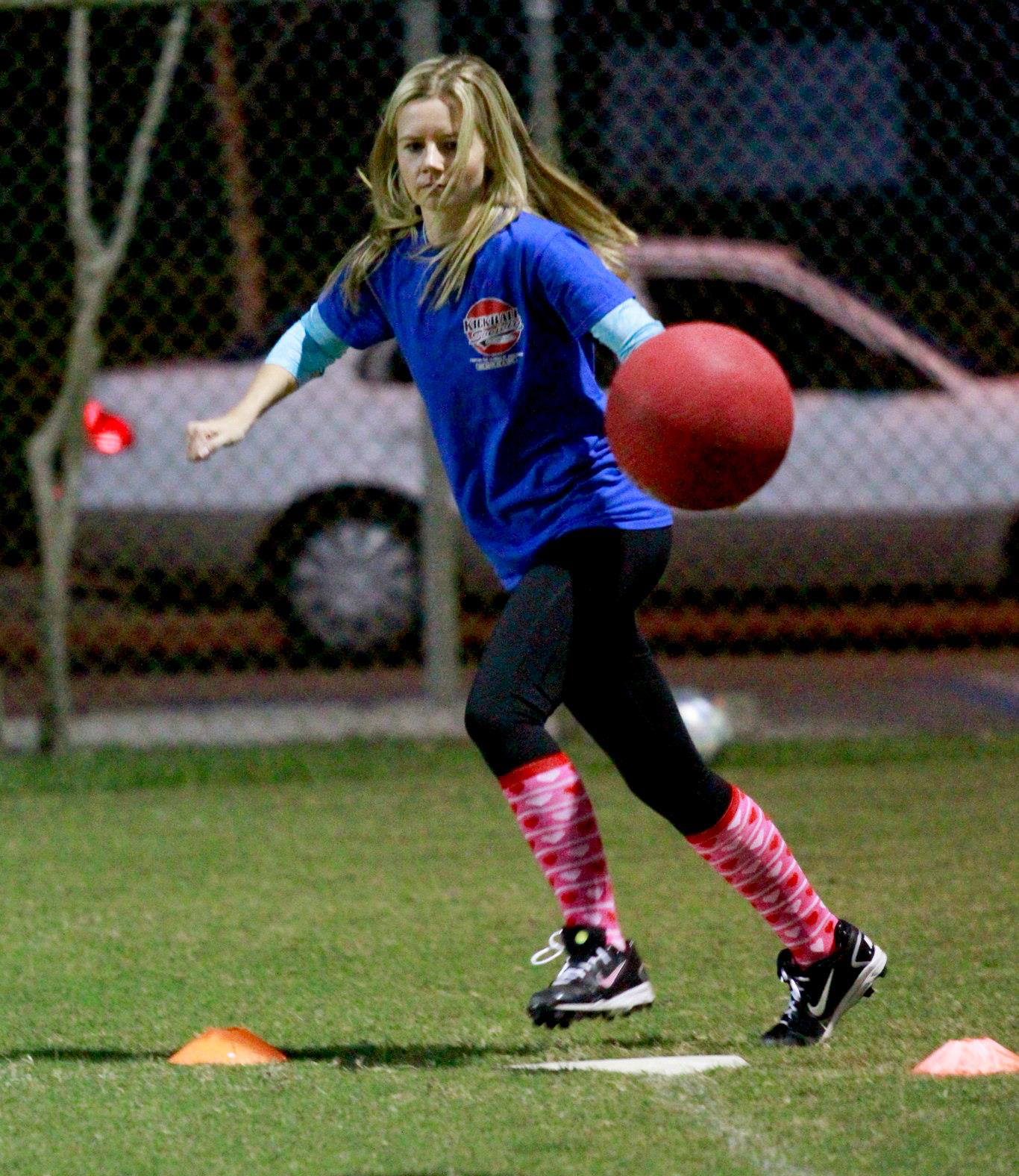
- Side Refs/Base Coaches (First & Third) are part of the field and are considered “In-Play”. Base Coaches and Side Refs will do their best to get out of the way of the play while not interfering with the current active play. Base Coaches must not interfere with line of sight of the Side Refs. Teams on offense are allowed one (1) Base Coach per sideline.
- Other Players: Offense/Defense: All players must stay behind the designated line that determines “Out of Bounds”. If an active ball hits an offensive player (other than the Base Coach or Side Ref), in foul territory, it’s an immediate “dead ball” and the runners will be held at current positions (based on the lead runner). Runners will NOT advance one base. If an active ball hits a defensive player, in foul territory, it’s an immediate “dead ball” and the runners will advance one base (based on the lead runner).
Overthrows:
- When a ball is overthrown and goes into “dead ball” territory and the ref calls it DEAD, any runners on the base paths will get ONE base ONLY. If the runner is headed towards a base, they will get the base they were headed towards. If the runner is already ON a base when the ball is called dead, then that runner will get the NEXT base. If there is more than one, or more runners on base, the lead runner controls where the runners are placed. The runners behind the lead runner cannot force the runner in front of them to move to another base EXCEPT if the OVERTHROWN ball is played at first base. When the OVERTHROW is at first base, the kicker/runner will get second base automatically. This will push any runners on base forward if they are forced to move because of the second base being awarded to the kicker/runner when the overthrow happened at first base ONLY.
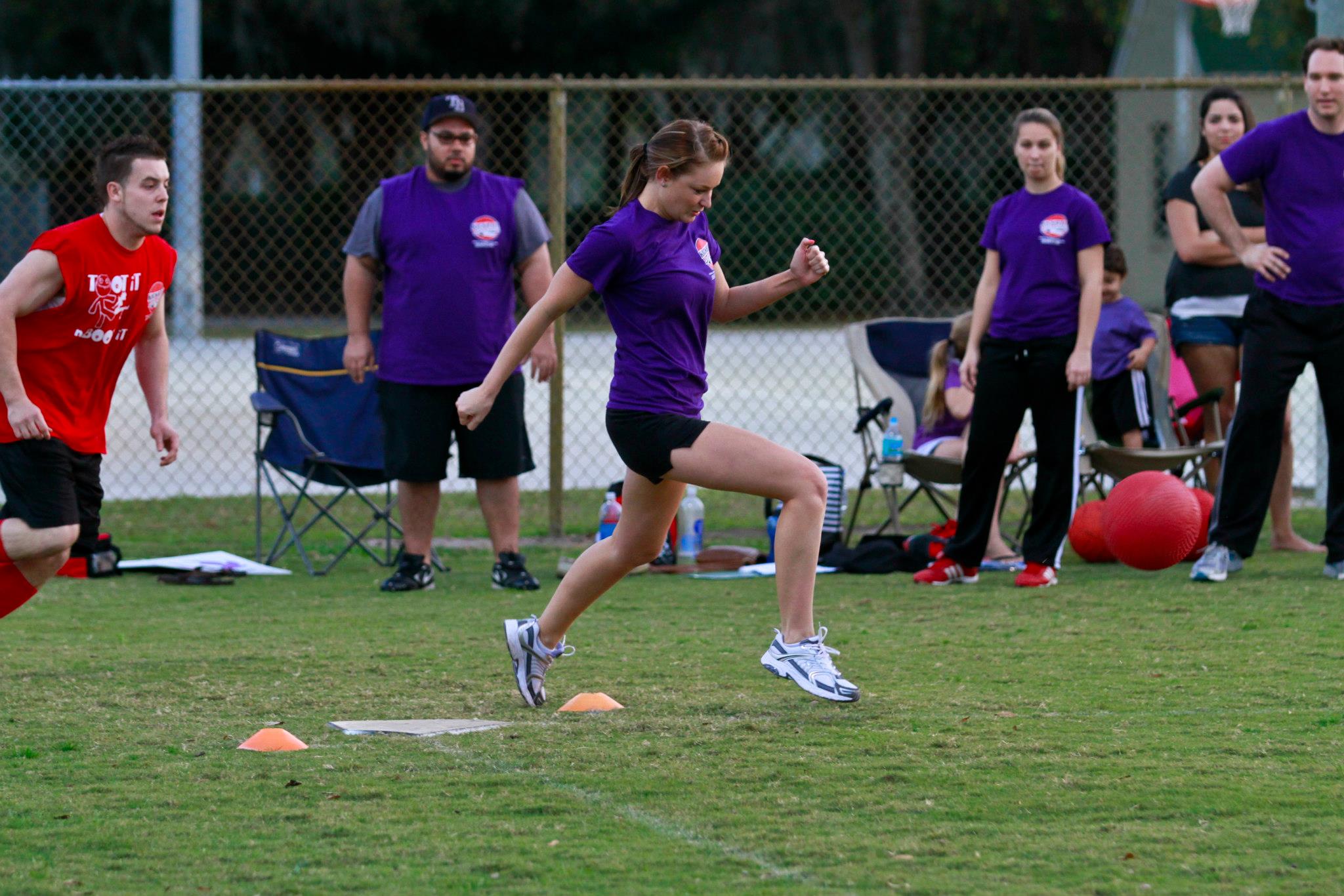
OUT OF BOUNDS:
- Any ball caught past the “out of bounds” area will NOT COUNT as catch, and will only be a foul ball.
- If a ball is caught in foul or fair territory and is carried past the out of bounds area between home and first/third baselines, the catch will not count, and it will be a foul ball.
- If a ball is caught in foul or fair territory and carried past the out of bounds area BEHIND first/third bases, the play will continue. Time will not be called until ball is in control of a fielder and the lead runner has stopped.
- If a fair ball is kicked, carried, thrown or deflected past the out of bounds area, the play will continue if it behind the first/third bases.
DEAD BALL (Because of touching another player or object in a different game):
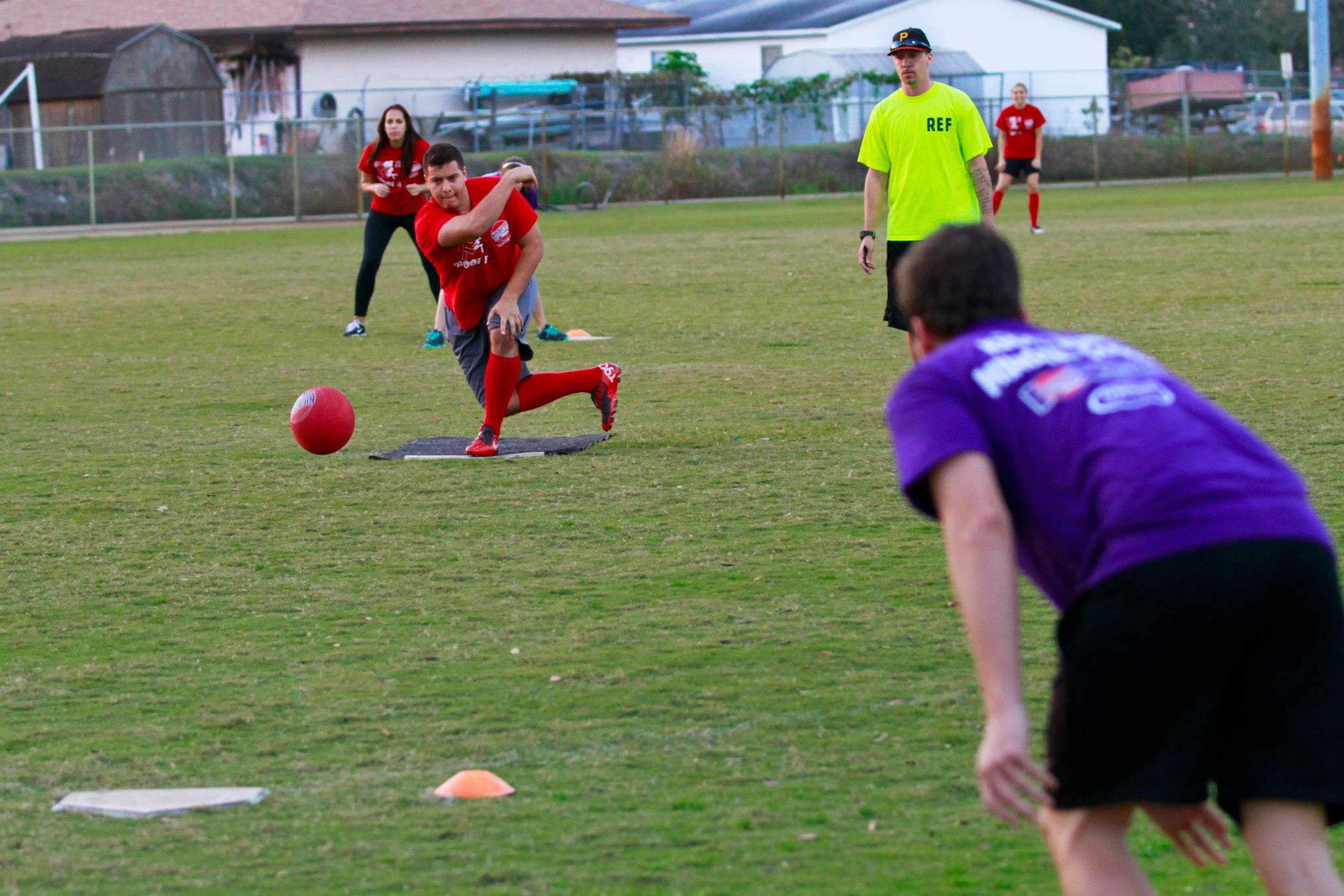
- When a ball travels into an object in the field or play, or into another field and is touched by a person on another team, or there is interference between the two players on either team, the referee will call “DEAD BALL” and any runners/kickers on base will get the base they were headed towards. The referee has the discretion to award the kicker and baserunners whatever additional bases(s) they could have reached had there not been a dead ball called.
Defense Obstruction:
- The defense cannot occupy a base until there is a play at the base (second/third). If the defense does occupy a base, it will be ruled as interference and the result of the play will have the referee either award the base or next base to the runner if the interference kept the baserunner from getting to the base or next base. If the result of the play had no disadvantage to the kicking team, no bases will be awarded.
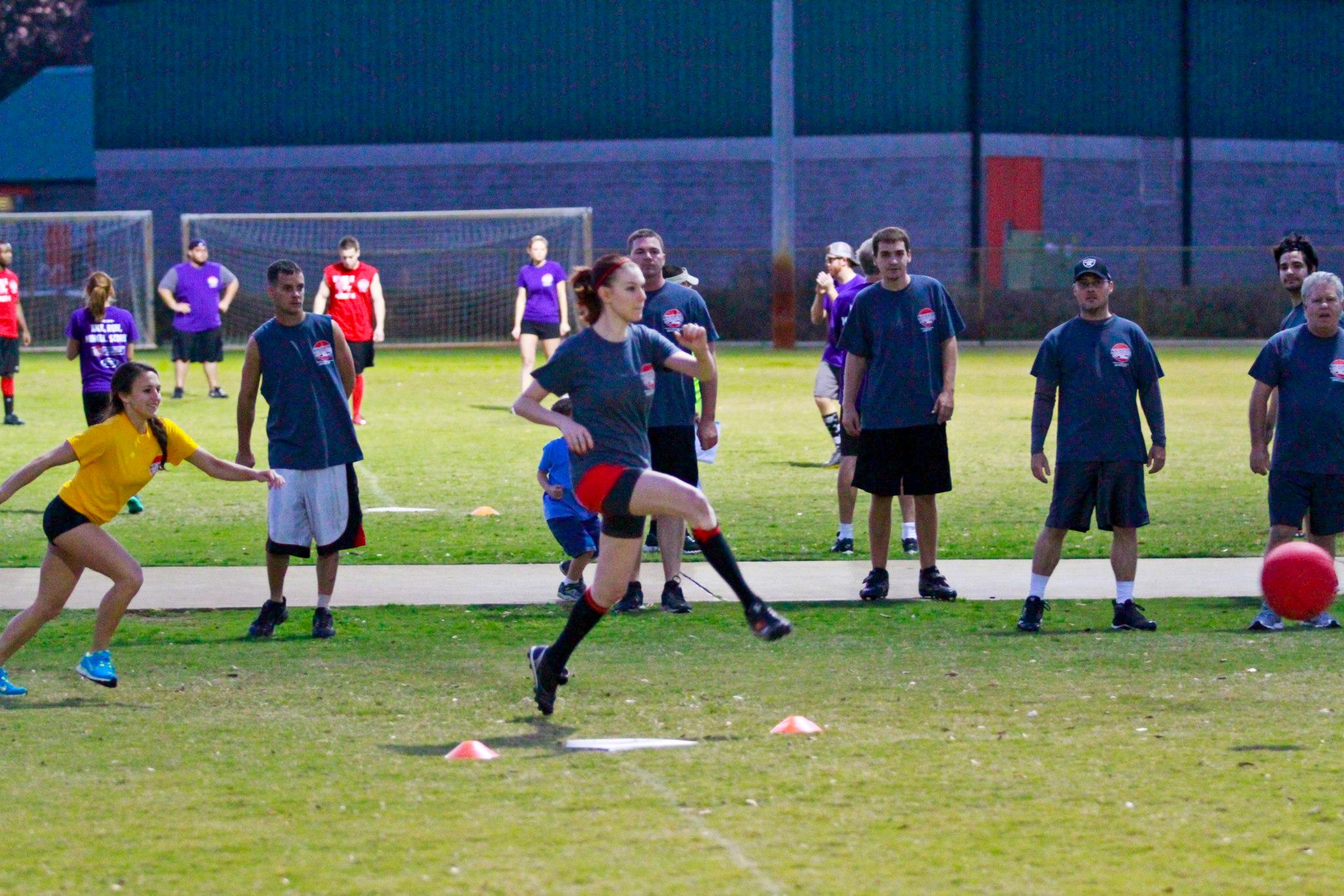
Sportsmanship
- Keep the game moving and no stalling! If the pitcher doesn’t deliver a pitch within 10 seconds of the referee calling for it, the referee will award a ball to the kicker. If a kicker isn’t ready to kick within 10 seconds of being called to the plate by the referee, the referee will call a strike on the kicker.
- Talking smack is permitted as long as its witty and clever, and not cruel, race/gender/sexual orientation/appearance related, or a personal attack on another team or player. (Seriously, don’t do this. It’s unacceptable.) Referees are empowered to issue warnings and ejections, and captains are responsible for ensuring team members behave themselves. Refer to Rule #1.
- Players should not have intentional or unwelcome contact with opposing team members. A player should inform the referee if they feel they are subject to any unwarranted contact and the referee will inform the team captain of the complaint. Referees are empowered to issue warnings or ejections if necessary. If a player is ejected, they are automatically suspended for the remainder of that game plus the following game. Again, refer to Rule #1.
- All team members are expected to comply with field rules, which may vary depending on the location of league play. Captains are responsible to ensure their team is familiar with field rules.
- Kickball Society reserves the right to suspend any player for unsportsmanlike conduct, violation of rules, failure to pay dues or for being a pain in the butt. No refunds. Team captains may appeal the suspension of a player but Kickball Society has the ultimate say. If any team wishes to suspend one of their players, they must provide Kickball Society an explanation of their reasons in writing.
- A player may be ejected based on the ref’s determination based on, but not limited to: unsportsmanlike conduct, physical altercation, verbal altercation deemed personal attack or threat to any other player or official. Captains are the only ones allowed to challenge calls that the refs have made on the field.
- A player can be asked to leave the field(s) or park complex immediately for any reason.
- A player ejected is automatically ejected from the current game and the immediate next game the team plays (be it that evening or the next week). In the event of an ejection during the playoffs, that person will be ejected from all remaining games that week.
- If a kicker is ejected during a game, when he/she comes up in the kicking order, the kicker who was ejected will be an AUTOMATIC OUT for the kicking team for the remainder of the game.
